AP Art History Final
1/31
There's no tags or description
Looks like no tags are added yet.
Name | Mastery | Learn | Test | Matching | Spaced |
|---|
No study sessions yet.
32 Terms

The Code of Hammurabi
No known artist
Date: 1792-1750 BCE
Place/Culture: Modern Iran (Susian) - Babylonian
Commission by: King Hammurabi
Material: Basalt stele
an ancient set of laws enacted by King Hammurabi, one of the earliest examples of written legal codes. It established rules and punishments for various offenses, reflecting the social and economic conditions of the time.

22. Akhenaten, Nefertiti, and three daughters
No Known Artist
Date:1353-1335 BCE
Place/Culture: New Kingdom Egypt (Armana Style - exaggerated bodies and elongated heads)
Material: Limestone relief
This famous relief sculpture depicts the Pharaoh Akhenaten, his wife Nefertiti, and their three daughters during a time of religious revolution in ancient Egypt, showcasing familial intimacy and divine connection. The purpose is to emphasize the royal family’s special relationship with the god Aten and promote the new monotheistic religion

30. Audience Hall (apadana) of Darius and Xerxes
No Known Artist
Date: 520-465 BCE
Place/Culture: Persepolis, Persia
Material: Stone and mud brick with relief sculptures
A monumental structure built to host receptions and ceremonies, exemplifying the grandeur of the Achaemenid Empire. The hall features impressive columns and reliefs that depict the diverse peoples of the empire paying tribute to the kings.

34. Doryphoros (Spear Bearer)
Artist: Polykleitos
Date: 450-440 BCE
Material: Originally bronze; existing Roman copies in marble
Style: Classical Greek sculpture emphasizing idealized human proportion
Doryphoros, also known as the Spear Bearer, exemplifies the Classical Greek approach to sculpture, marked by its focus on symmetry and balance. Polykleitos developed a mathematical formula for ideal proportions, influencing subsequent generations of artists. Contrapposto and once held a spear.

35. Acropolis
Architects/Artists: Iktinos and Kallikrates (Parthenon), Phidias (sculptures)
Date: c. 447–410 BCE
Location: Athens, Greece
Material: Marble
Commissioned by: Pericles, leader of Athens
The Acropolis is an ancient citadel located above the city of Athens, famed for its classical Greek architecture, including the Parthenon. It served as a religious center dedicated to the goddess Athena and symbolized the power and culture of Athens during its Golden Age.
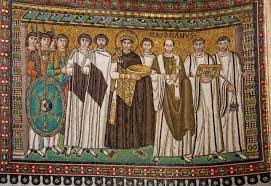
51. San Vitale
Location: Ravenna, Italy
Date: c. 526–547 CE
Culture: Early Byzantine
Material: Brick, marble, mosaic, stone veneer
Commissioned by: Bishop Ecclesius, supported by Emperor Justinian
Church meant to glorify God and assert imperial and ecclesiastical power. Early model of Byzantine theocratic art. Showed imperial power united with divine sanction.
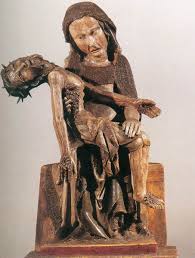
62. Röttgen Pietà
Artist: Unknown German sculptor
Date: c. 1300–1325 CE (Late Gothic)
Material: Painted wood (polychromed)
Commissioned by: Likely for private devotion in a chapel or home
Culture/Place: Rhineland (Mainz region), Germany
Designed as an emotional devotional piece emphasizing human suffering through exaggerated anatomy and raw facial expressions. It facilitated empathy and meditation on Christ’s suffering, aligning with growing affective piety in late medieval Europe

63. Arena (Scrovegni) Chapel – Lamentation by Giotto
Artist: Giotto di Bondone
Date: Fresco c. 1304–1306 CE
Material: Buon fresco on plaster
Commissioned by: Enrico Scrovegni (wealthy banker) for a private chapel
Culture/Place: Padua, Italy (Proto‑Renaissance)
The artwork humanizes biblical narrative with naturalistic emotion and three‑dimensional form, marking a shift from Byzantine flatness. It was part of a moral and theological program narrating Christ’s life and the Last Judgment within a private devotional context.
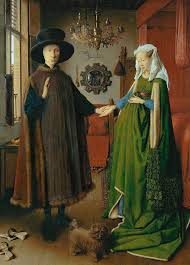
68. The Arnolfini Portrait
Artist: Jan van Eyck
Date: c. 1434 CE
Material: Oil on wood panel
Commissioned by: Giovanni di Nicolao Arnolfini (merchant)
Culture/Place: Bruges, Burgundian Netherlands
Style: Northern Renaissance
A double portrait rich in symbolic objects (e.g., dog, mirror, oranges) that reference marriage, wealth, and fidelity. It showcases meticulous detail and early use of oil paint to achieve luminous realism and mirror reflections.
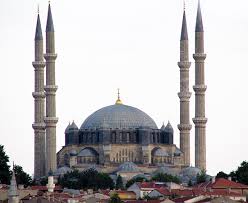
84. Mosque of Selim II
Artist: Sinan (chief Ottoman architect)
Date: 1568–1575 CE
Material: Brick, stone, Iznik tile
Commissioned by: Sultan Selim II
Culture/Place: Edirne, Ottoman Empire (modern Turkey)
Acts as a centralised-domed imperial mosque reflecting the architectural zenith of Ottoman design. It emphasizes centralized spatial harmony and elevation surpassing Hagia Sophia, showcasing Sinan’s mastery of structure and light.
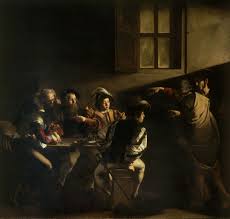
85. Calling of Saint Matthew
Artist: Caravaggio (Michelangelo Merisi)
Date: c. 1597–1601 CE
Material: Oil on canvas
Commissioned by: Contarelli Chapel, San Luigi dei Francesi, Rome
Culture/Place: Baroque Italy
Style: Baroque
A dramatic portrayal of the moment Christ calls Matthew, using tenebrism to spotlight the figures and heighten emotional intensity. The everyday setting combined with stark realism marked a breakthrough in Baroque religious painting.
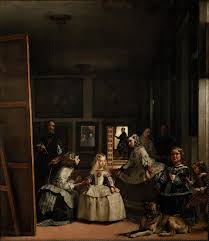
91. Las Meninas
Artist: Diego Velázquez
Date: c. 1656 CE
Material: Oil on canvas
Commissioned by: King Philip IV of Spain
Style: Spanish Baroque
Culture/Place: Spanish Golden Age, Madrid
A complex, self-referential scene blending court portraiture and studio realism, with the viewer positioned as the King and Queen. It challenges perception through layered gazes, mirrors, and uncommon spatial ambiguity. Velázquez includes himself in the act of painting—asserting the status of the artist. Naturalistic light and psychological presence of each figure

93. The Palace at Versailles
Architects: Louis Le Vau & Jules Hardouin-Mansart; gardens by André Le Nôtre
Date: Begun 1669 CE (expanded through 18th c.)
Material: Masonry, marble, wood, iron, gold leaf, bronze
Commissioned by: King Louis XIV
Culture/Place: Royal France
Style: French Baroque
A monumental expression of absolutist power and grandeur, blending classical architecture with lavish interiors and formal gardens. Versailles functioned as both palace and political tool to centralize French governance under the Sun King (Louis XIV).

98. The Tête à Tête, from Marriage à la Mode
Artist: William Hogarth
Date: c. 1743 CE
Material: Oil on canvas
Commissioned by: Part of Hogarth’s own satirical series (Marriage à la Mode), intended for publication as engravings
Culture/Place: Rococo moral satire, London, England
Style: Satirical genre painting (English moral Rococo)
A biting social commentary on aristocratic marriage: visual clues (syphilis, unpaid bills, a bored couple) criticize vanity and moral decay. Designed to amuse and instruct the public on the perils of marrying for status
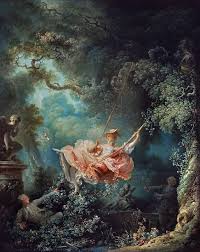
101. The Swing
Artist: Jean-Honoré Fragonard
Date: 1767 CE
Material: Oil on canvas
Commissioned by: Baron de Saint-Julien (to depict his mistress for private display)
Culture/Place: French Rococo, Paris
Style: Rococo
A playful, erotic celebration of aristocratic leisure—voluptuous brushwork, pastel tones, hidden references to illicit romance (shoe, putti, voyeur below). Reflects Rococo’s delight in intimacy and frivolity
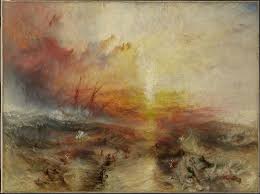
111. Slave Ship (« Slavers Throwing Overboard the Dead and Dying… »)
Artist: J. M. W. Turner
Date: 1840 CE
Material: Oil on canvas
Commissioned by: Commissioned by abolitionist Thomas Griffiths Wainewright? (Exhibited at Royal Academy 1840)
Culture/Place: British Romanticism
Style: Romanticism
A dramatic, emotional protest against the slave trade, rendered in swirling colors and violent composition. Highlights nature’s power and human cruelty, aiming to shock the viewer into moral reckoning.
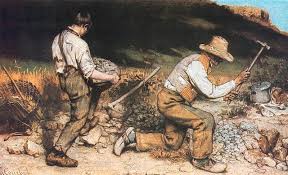
113. The Stone Breakers (destroyed 1945)
Artist: Gustave Courbet
Date: 1849 CE
Material: Oil on canvas
Commissioned by: Not commissioned (exhibited at Paris Salon 1850)
Culture/Place: French Realism
Style: Realism
Unvarnished portrayal of rural laborers engaged in back‑breaking work; monumental scale emphasizes physical toil and social injustice, rejecting idealization to spotlight class and labor issues.
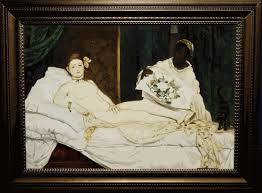
115. Olympia
Artist: Édouard Manet
Date: 1863 CE
Material: Oil on canvas
Commissioned by: Submitted independently to Salon, no private patron
Culture/Place: French Realism / Pre‑Impressionism
Style: Realism
A confrontational nude—modern, direct, and unidealized—sparking scandal at the 1865 Salon. Olympia’s gaze challenges traditional passivity, marking a turning point toward modernism and a critique of academic norms.

126. Les Demoiselles d’Avignon
Artist: Pablo Picasso
Date: 1907 CE
Material: Oil on canvas
Commissioned by: Not commissioned (retained by Picasso until sold)
Culture/Place: Paris, early Modern Europe
Style: Proto-Cubism / Early Cubism
Picasso radically broke from traditional representation with jagged forms and mask-inspired faces, depicting five prostitutes from Avignon’s red-light district. This work marked a pivotal shift toward Cubism, confronting viewers with fragmented space and multiple perspectives

136. Composition with Red, Blue and Yellow
Artist: Piet Mondrian
Date: 1930 CE
Material: Oil on canvas
Commissioned by: Not commissioned (studio work)
Culture/Place: De Stijl movement, Netherlands/France
Style: Neo-Plasticism (Abstract Modernism)
Mondrian sought an abstract visual harmony of balance and tension using primary colors and grid lines. This painting exemplifies his belief in art's ability to express universal truths beyond natural representation
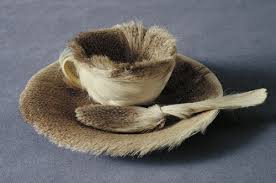
138. Object (Le Déjeuner en fourrure)
Artist: Meret Oppenheim
Date: 1936 CE
Material: Fur-covered teacup, saucer, and spoon (sculptural readymade)
Commissioned by: Created for a Surrealist exhibition
Culture/Place: Surrealism, Paris
Style: Surrealist object/assemblage
This playful yet unsettling work subverts everyday domesticity by covering a teacup in fur, evoking fetishism and disturbing comfort zones. It exemplifies Surrealism’s use of unexpected juxtapositions to tap into the subconscious.
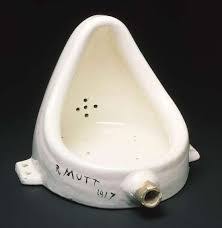
144. Fountain (second version)
Artist: Marcel Duchamp
Date: 1950 CE (Replica of 1917 original)
Material: Porcelain sanitary china, black paint
Commissioned by: Replica produced by Duchamp intentionally after being lost
Culture/Place: Dada / Readymade, France / New York
Style: Dada / Conceptual art
By repurposing a urinal as art with a pseudonym signature (“R. Mutt”), Duchamp challenged traditional definitions of art and authorship. Its irreverent gesture paved the way for conceptual art and the use of everyday objects in art contexts.

164. Transformation Mask (Thunderbird)
Artist: Kwakwaka’wakw (Namgis clan); crafted by master carvers
Date: Late 19th century CE
Material: Red cedar, pigments, leather, nails, metal plate; feathers and bark in some examples
Commissioned by / For: Kwakwaka’wakw potlatch ceremonies, led by chiefs or hereditary holders of mask traditions
Culture/Place: Kwakwaka’wakw, Pacific Northwest (Alert Bay region, Vancouver Island, Canada)
Style: Indigenous Northwest Coast ceremonial art
Designed for dramatic ritual dance, the mask transforms via hinges to reveal an inner human face, symbolizing the metamorphosis from spirit to human. Used in potlatches celebrating clan history, social status, and supernatural myths, it embodies spiritual renewal and ancestral connections
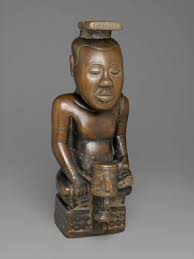
171. Ndop (Portrait Figure) of King Mishe miShyaang maMbul
Artist: Kuba peoples (anonymous, professional carver)
Date: c. 1760–1780 CE
Material: Hardwood sculpture (carved and oiled with palm oil)
Commissioned by: King Mishe miShyaang maMbul himself, as a commemorative portrait to assert his legacy
Culture/Place: Kuba Kingdom, Democratic Republic of the Congo
Style: African royal portrait sculpture
Serving as a symbolic representation of the king’s spirit, the ndop idealizes his qualities rather than his literal appearance. It was housed in the king’s quarters and used in rituals to maintain his presence and ensure effective rulership, marked by an identifying emblem at its base

196. Gold and Jade Crown
Artist: Unknown, Silla royal artisans
Date: 5th–6th century CE
Material: Gold sheet and jade pendants
Commissioned by / For: Elite burial in Silla Kingdom royal tombs
Culture/Place: Three Kingdoms Period, Silla, Korea
Style: Korean funerary regalia
This crown, discovered in royal burials, symbolizes the ruler’s divine authority and afterlife prestige. Its vertical gold projections mimic stylized tree or antler forms, reflecting shamanistic Yang patterns and cosmic beliefs of the Silla culture.
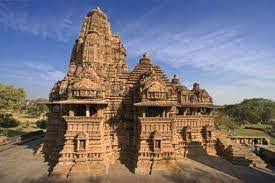
200. Lakshmana Temple
Artist/Builder: Chandella Dynasty architects and artisans
Date: c. 930–950 CE
Material: Sandstone
Commissioned by: King Yashovarman (Chandella ruler)
Culture/Place: Hindu temple in Khajuraho, Madhya Pradesh, India
Style: Nagara (North Indian Hindu temple architecture)
Built to honor Vishnu in his Vaikuntha form, the temple reflects cosmic symbolism through its axial alignment and tiered towers (shikharas). Its elaborate erotic and divine sculptures express spiritual union and dharma, merging earthly and divine realms.
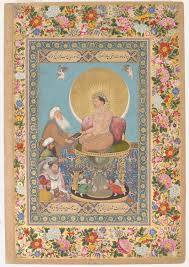
208. Jahangir Preferring a Sufi Shaikh to Kings
Artist: Bichitr
Date: c. 1620 CE
Material: Opaque watercolor, gold, and ink on paper
Commissioned by: Emperor Jahangir
Culture/Place: Mughal Empire, India
Style: Mughal miniature painting
This imperial portrait illustrates Jahangir’s preference for spiritual authority (Sufi Shaikh) over worldly power (Ottoman sultan, King James I). It uses hieratic scale and symbolic motifs (hourglass, halo) to depict his divine right and piety.
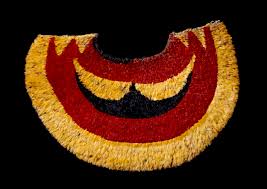
215. ‘Ahu ‘ula (Feather Cape)
Artist: Hawaiian artisans
Date: Late 18th century CE
Material: Feathers (ʻōʻō, ʻiʻiwi birds) and fiber netting
Commissioned by: Hawaiian nobility (aliʻi), often for chiefs and warriors
Culture/Place: Hawaii, Polynesian culture
Style: Indigenous Hawaiian regalia
Worn in battle or ceremonial events, this feather cloak symbolized mana (spiritual power), nobility, and protection. Thousands of feathers were carefully tied to a netted base, reflecting both social rank and sacred responsibility.

230. Pink Panther
Artist: Jeff Koons
Date: 1988 CE
Material: Glazed porcelain
Commissioned by: Created as part of Koons’s Banality series
Culture/Place: Postmodern American art
Style: Neo-Pop / Kitsch sculpture
This highly polished figurine critiques celebrity culture and consumerism, depicting Jayne Mansfield with the Pink Panther in a sexualized, cartoonish pose. Koons elevates kitsch to fine art, blurring boundaries between high and low culture.
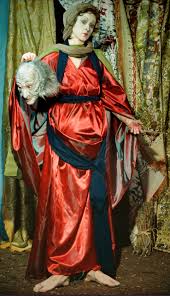
231. Untitled #228, from the History Portraits series
Artist: Cindy Sherman
Date: 1990 CE
Material: Chromogenic color print (photograph)
Commissioned by: Not specifically commissioned; part of her studio work
Culture/Place: American feminist photography
Style: Postmodern / Feminist conceptual photography
Sherman inserts herself into iconic roles from art history to question gender, identity, and authorship. In #228, she plays Judith from the biblical story, subverting classical depictions of female virtue or victimhood with unsettling parody.
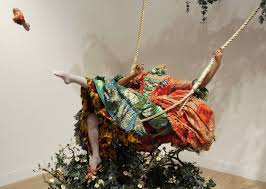
244. The Swing (after Fragonard)
Artist: Yinka Shonibare
Date: 2001 CE
Material: Mixed-media installation (mannequin, fabric, artificial foliage)
Commissioned by: Tate London
Culture/Place: British-Nigerian / Diaspora contemporary art
Style: Postcolonial / Conceptual / Installation art
This reimagining of Fragonard’s Rococo painting replaces the white aristocrat with a headless Black figure in African-print fabric. Shonibare critiques colonial history, class privilege, and identity, making visible what was omitted in European art history.
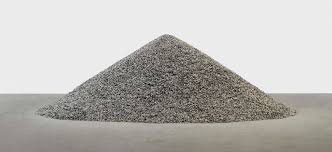
250. Kui Hua Zi (Sunflower Seeds)
Artist: Ai Weiwei
Date: 2010–2011 CE
Material: Sculpted and hand-painted porcelain (millions of pieces)
Commissioned by: Tate Modern (original installation in Turbine Hall)
Culture/Place: Contemporary Chinese art
Style: Conceptual installation / Social practice art
Each porcelain sunflower seed is handmade, recalling traditional Chinese craft but scaled into a monumental critique of mass production and individuality under authoritarian regimes. The work also reflects Maoist propaganda, where citizens were called "sunflowers" loyal to the "sun" (Mao).